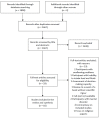Voluntary stopping of eating and drinking at the end of life - a 'systematic search and review' giving insight into an option of hastening death in capacitated adults at the end of life
- PMID: 24400678
- PMCID: PMC3893440
- DOI: 10.1186/1472-684X-13-1
Voluntary stopping of eating and drinking at the end of life - a 'systematic search and review' giving insight into an option of hastening death in capacitated adults at the end of life
Abstract
Background: The terminally ill person's autonomy and control are important in preserving the quality of life in situations of unbearable suffering. Voluntary stopping of eating and drinking (VSED) at the end of life has been discussed over the past 20 years as one possibility of hastening death. This article presents a 'systematic search and review' of published literature concerned with VSED as an option of hastening death at the end of life by adults with decision-making capacity.
Methods: Electronic databases PubMed, EBSCOhost CINAHL and Ovid PsycINFO were systematically searched. Additionally, Google Scholar was searched and reference lists of included articles were checked. Data of the included studies were extracted, evaluated and summarized in narrative form.
Results: Overall, out of 29 eligible articles 16 were included in this review. VSED can be defined as an action by a competent, capacitated person, who voluntarily and deliberately chooses to stop eating and drinking with the primary intention of hastening death because of the persistence of unacceptable suffering. An estimated number of deaths by VSED was only provided by one study from the Netherlands, which revealed a prevalence of 2.1% of deaths/year (on average 2800 deaths/year). Main reasons for patients hastening death by VSED are: readiness to die, life perceived as being pointless, poor quality of life, a desire to die at home, and the wish to control the circumstances of death. The physiological processes occurring during VSED and the supportive care interventions could not be identified through our search.
Conclusions: The included articles provide marginal insight into VSED for hastening death. Research is needed in the field of theory-building and should be based on qualitative studies from different perspectives (patient, family members, and healthcare workers) about physiological processes during VSED, and about the prevalence and magnitude of VSED. Based on these findings supportive care interventions for patients and family members and recommendations for healthcare staff should be developed and tested.
Figures
References
-
- Patrick DL, Curtis JR, Engelberg RA, Nielsen E, McCown E. Measuring and improving the quality of dying and death. Ann Intern Med. 2003;139(5 Pt 2):410–415. - PubMed
LinkOut - more resources
Full Text Sources
Other Literature Sources
Miscellaneous


